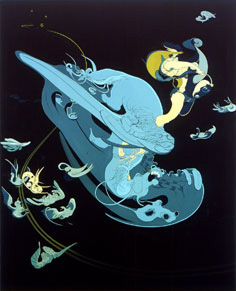Inka Essenhigh

Pegasus, 2002
- Essenhigh in conversation with Bradley Rubenstein
- Essenhigh at Victoria Miro
- Essenhigh.com
- Essenhigh at Albright Knox: 1, 2
- Essenhigh at Fruitmarket
Update, April 24th: Since so many people are finding their way to this page via the search engines, I thought I’d add the preview piece I wrote for The List magazine on Essenhigh. It was a tricky interview, because, as you can see, none of my ideas about Essenhigh’s work were shared by the artist. And I was hungover.
Inka Essenhigh makes spectacular paintings. They are spectacularly weird too. Her canvases are peopled with plastic and flesh mutants that bulge improbably and trail stringy appendages behind them, like the results of a failed experiment to breed mammal and machine. These creatures are superheroes, too, or the gods of a future mythology, always in motion, made flesh with the bold outlines and blocky colours of cartoons. The sort of cartoons that would have been made if Walt Disney had handed over the reigns of his studio to a committee of Surrealists. Bacon is in there too somewhere, in the pinks and oranges, and the horrified, cynical world-view. Pop rears it’s head from time to time as well, in Essenhigh’s depiction of disco dancers and wrestlers, her tendency to chew up and spit out the familiar and everyday, making the banal fantastic.
Her paintings are so easily read in terms of influence and allusion, it seems as if the alternate universe Essenhigh maintains across her paintings is in part a dialogue between painting’s past and post-painting popular culture. Ask Essenhigh how she draws together so wide a frame of reference, though, and she laughs: ‘I have no idea! There’s nothing I’m really trying to reference or draw from. If I’m making a painting, I’m just going by what it looks like, it’s good as long as it looks good to me, whatever that means. That changes, but if i need a big blue spot up in the left hand corner, then I put that big blue spot on there and figure out what it is afterwards, I see how it works later.’
For Essenhigh, then, it’s all about the painting, the technical act of applying paint to a canvas. ‘I always think that you could spot one of my paintings,’ she says, ‘They have a distinct style, but all people seem to do is try to list my sources. If someone comes along and says this painting or that painting looks like Disney, my first instinct is to try and change it. What I do is about style and about beauty, and I’m searching for a style that incorporates being beautiful and traditional, that incorporates ideas of aesthetics from contrapasto to Bauhaus ideas of colour, shape and line. I want it to be all that, and to be something that the middle class can like. My paintings have straightforward raw energy in them, and that’s what comes across as being cartoony and not fine arty. Those abstract qualities are in there, but without pretension.’
It is almost as if Essenhigh is so close to her own work, so involved in the work of making, that she cannot see beyond herself as painter and her work as painting. Even when pressed to consider the meaning that jumps out at the viewer in a work like WWF, a clear satire on the overblown fakery of professional wrestling, Essenhigh soon turns to talking in terms of making marks with her brush. ‘I’m drawn to all this theatre that doesn’t have a human scale,’ she explains, ‘What I want out of a painting is a certain amount of grand gesture, but I then want to inject it with something smaller, something comical, something human. If there is a grand sweeping gesture, I always like to counteract it with some side relief, some smaller gesture, something tiny at the side. They are abstract marks on the canvas that might turn into people, figures.’
In the end, this might be what makes Essenhigh great. For all the futuristic tropes in her work, she is something of a traditionalist. Her work isn’t a set of themes and ideas realised through a medium, instead, that medium is the driving force, and her show at the Fruitmarket should be seen as about, for and because of painting, pure and simple.

 Submit Response is a weblog by Jack Mottram, a
Submit Response is a weblog by Jack Mottram, a
Hi! I also found you through the search engines while looking up Inka Essenhigh. Thought I’d submit another resource for your consideration— there’s a good page about her on the Saatchi Gallery site with bio, works, references, and more. :)
Posted by Kathryn at 1am on 03.03.06